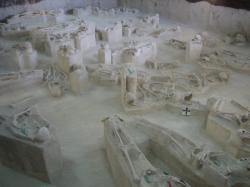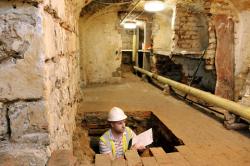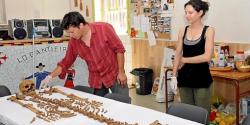INSTITUT SUPERIEUR D'ANTHROPOLOGIE
INSTITUTE OF ANTHROPOLOGY
ONLINE COURSES / COURS A DISTANCE
INSCRIPTION : Année Universitaire 2012/2013
REGISTRATION : Academic Year 2012 / 2013
CUBA –  Chorro de Maita - New evidence that change perceptions and concepts on the famous aboriginal burial ground Chorro de Maita, in the municipality of Banes, Holguin, was found as a result of the deepening of archaeological research carried out here. The very existence of that site contradicts the practice of the natives to leave the dying or dead in the woods or in caves, said archaeologist Roberto Valcarcel Rojas, principal investigator of this site. Valcarcel, who is also an specialist at the Eastern Archaeology Center, added that a village of Comendeds seattled in the area of the Chorro de Mait, where it was established a Christian-based cemetery, though not completely so, nor Aboriginal. He added that this cemetery, discovered in 1986, is the first of its kind found in the Caribbean and one of the oldest in the Americas. He further stated that during the investigation specialists recognized the remains of two mestizos, one of them a mixture of native and African and the other one the mixture of Spanish with a native, who were probably the oldest Creole known in Cuba and the Carribbean. On this last point, Valcarcel said that they were surprised while identifying the remains of a Negro from North African and a Mesoamerican aboriginal woman, apparently from Mexico's Yucatan area. This finding reveals an unexpected ethnic diversity in the cemetery, located on the hill of Yaguajay, near the famous beach of Guardalavaca, first tourist destination of Holguin. The research carried out in this area also showed a territorial plurality, as 23 individuals buried there were not from the region. It also higlights the cultural variety appreciated in the Aboriginal and non Aboriginal practices in burials, particularly that many individuals, including natives, were buried with their clothes, something really unusual, while the fabric used was Mediterranean's linen.
Chorro de Maita - New evidence that change perceptions and concepts on the famous aboriginal burial ground Chorro de Maita, in the municipality of Banes, Holguin, was found as a result of the deepening of archaeological research carried out here. The very existence of that site contradicts the practice of the natives to leave the dying or dead in the woods or in caves, said archaeologist Roberto Valcarcel Rojas, principal investigator of this site. Valcarcel, who is also an specialist at the Eastern Archaeology Center, added that a village of Comendeds seattled in the area of the Chorro de Mait, where it was established a Christian-based cemetery, though not completely so, nor Aboriginal. He added that this cemetery, discovered in 1986, is the first of its kind found in the Caribbean and one of the oldest in the Americas. He further stated that during the investigation specialists recognized the remains of two mestizos, one of them a mixture of native and African and the other one the mixture of Spanish with a native, who were probably the oldest Creole known in Cuba and the Carribbean. On this last point, Valcarcel said that they were surprised while identifying the remains of a Negro from North African and a Mesoamerican aboriginal woman, apparently from Mexico's Yucatan area. This finding reveals an unexpected ethnic diversity in the cemetery, located on the hill of Yaguajay, near the famous beach of Guardalavaca, first tourist destination of Holguin. The research carried out in this area also showed a territorial plurality, as 23 individuals buried there were not from the region. It also higlights the cultural variety appreciated in the Aboriginal and non Aboriginal practices in burials, particularly that many individuals, including natives, were buried with their clothes, something really unusual, while the fabric used was Mediterranean's linen.
http://www.cadenagramonte.cu/english/index.php?option=com_content&view=article&id=11786:new-archaeological-evidence-found-in-cuban-museum&catid=2:cuba&Itemid=14
ROYAUME UNI –  York - Buried deep beneath York’s historic Guildhall and Mansion House complex lie centuries of secrets from the city’s prosperous past. Archaeologists have been excavating the Guildhall yard, the basements of the Mansion House, and an underground passageway leading to the River Ouse known as Common Hall Lane. It’s the first-ever archaeological dig on the site. Work has been going on at the site over two weeks and expensive 18th century blue and white Delft tiles have been found in the Guildhall yard, as well as a clay pipe and fragments of pottery and glass dating back to the 1720s, when the current Mansion House was being built. In Common Hall Lane medieval pottery and the neck of an 18th century wine bottle, amazingly well preserved in the soft soil, are among the finds the public will be able to see from Monday. Mr Howlett said: “We are trying to understand how this part of the landscape has changed since Roman times when there was a Roman gate in St Helen’s Square connecting what is now Stonegate to the river.
York - Buried deep beneath York’s historic Guildhall and Mansion House complex lie centuries of secrets from the city’s prosperous past. Archaeologists have been excavating the Guildhall yard, the basements of the Mansion House, and an underground passageway leading to the River Ouse known as Common Hall Lane. It’s the first-ever archaeological dig on the site. Work has been going on at the site over two weeks and expensive 18th century blue and white Delft tiles have been found in the Guildhall yard, as well as a clay pipe and fragments of pottery and glass dating back to the 1720s, when the current Mansion House was being built. In Common Hall Lane medieval pottery and the neck of an 18th century wine bottle, amazingly well preserved in the soft soil, are among the finds the public will be able to see from Monday. Mr Howlett said: “We are trying to understand how this part of the landscape has changed since Roman times when there was a Roman gate in St Helen’s Square connecting what is now Stonegate to the river.
http://www.yorkpress.co.uk/news/9856508.York___s_secret_past_hidden_beneath_Guildhall_and_Mansion_House/
KENYA – Malindi - Kenyan and Chinese archaeologists yesterday made another major breakthrough in their excavation work after they discovered prisoners’ shackles and spent cartridges at a mass grave in Malindi. The experts described the items as a possible link that indicated there were military activities in Malindi Kingdom and the Kenyan coast. In their latest findings at the site, which had over 15 mammalian skeletons, the archeologists also found skeletons believed to be of wild animals together with those that are human-like. Other discoveries in the ‘mass grave site’ were Indian and Chinese pottery materials, which the excavators said was a clear proof that Malindi had trade links with the Far East during the pre-colonial era. The Archeologist said they could however not ascertain whether the skeletons were those of prisoners of war until further analysis. “There is also pottery materials related to Indians, a clear indication that the Coastal Community traded with the Indians,’’ he said. The site where the mammalian skeletons were found at the Malindi chief’s office is near the Indian Ocean and very close to the former water mark and which has now turned to be a riparian land. Other sites identified include the Malindi Museum and Mamburui which is believed to have existed in the past 1400 years ago. Research being undertaken is aimed to trace Chinese trade links and dubbed the ‘CINO’ Kenya.
http://www.the-star.co.ke/local/coast/88081-malindi-archaeologists-make-new-discoveries
FRANCE -  La Granède - Venus des quatre coins de France, une vingtaine d’archéologues, professionnels et étudiants, se sont penchés cet été encore sur le site de la Granède, situé près de la ferme de l’hôpital du Larzac. Depuis la fin des années 2000, sous la direction de Christophe Saint-Pierre, chercheur pour le compte du service départemental d’archéologie, cet oppidum, signalé depuis 1921 et exploré par Louis Balsan dans les années 1950, fait l’objet de nouvelles fouilles en vue d’une importante publication scientifique, prévue en 2013, au mieux. Les archéologues s’intéressent essentiellement aux périodes d’occupation médiévales, de la fin du Ve au XIIIe siècles, même si le site a vraisemblablement été occupé dès le néolithique (2 800 avant J.-C.) et que les traces de trois occupations antérieures à notre ère ont été relevées. Ce site archéologique est ce que les spécialistes appellent un cap barré, sorte de promontoire ou d’avancée de terre surplombant la vallée. Les vestiges de fortification ont été mis au jour, les premiers datant du IIe siècle avant J.-C., les seconds du Ve siècle. Ces dernières années, les archéologues ont concentré leurs recherches sur les restes d’une église, probablement érigée sur les fondations d’un fanum, lieu de culte gallo-romain, et en activité à partir de la seconde moitié du Ve siècle. Plus d’une centaine de tombes ont été découvertes dans le cimetière attenant. Tout au long du mois de juillet, deux équipes se sont partagé les tâches : la première sur le site pour poursuivre les relevés, la seconde à Millau, dans les locaux mis à disposition par le groupe folklorique Lo Gantieirelo, pour inventorier, laver, classer et emballer le "mobilier", expédié ensuite dans les centres de recherche de Lattes et de Bordeaux. "Il y a sur cette campagne de fouilles de vrais spécialistes de la céramique et de l’anthropologie, dont deux anthropologues américains", indique Maxime Scrinzi, céramologue au sein de l’unité mixte de recherche (UMR) de Montpellier. Depuis la reprise des fouilles, 144 squelettes ont été exhumés. "Leur bon état de conservation permet notamment de découvrir les pathologies dont souffrait la population à l’époque", précisent Louise et Michaël, anthropologues rattachés à l’université de Bordeaux.
La Granède - Venus des quatre coins de France, une vingtaine d’archéologues, professionnels et étudiants, se sont penchés cet été encore sur le site de la Granède, situé près de la ferme de l’hôpital du Larzac. Depuis la fin des années 2000, sous la direction de Christophe Saint-Pierre, chercheur pour le compte du service départemental d’archéologie, cet oppidum, signalé depuis 1921 et exploré par Louis Balsan dans les années 1950, fait l’objet de nouvelles fouilles en vue d’une importante publication scientifique, prévue en 2013, au mieux. Les archéologues s’intéressent essentiellement aux périodes d’occupation médiévales, de la fin du Ve au XIIIe siècles, même si le site a vraisemblablement été occupé dès le néolithique (2 800 avant J.-C.) et que les traces de trois occupations antérieures à notre ère ont été relevées. Ce site archéologique est ce que les spécialistes appellent un cap barré, sorte de promontoire ou d’avancée de terre surplombant la vallée. Les vestiges de fortification ont été mis au jour, les premiers datant du IIe siècle avant J.-C., les seconds du Ve siècle. Ces dernières années, les archéologues ont concentré leurs recherches sur les restes d’une église, probablement érigée sur les fondations d’un fanum, lieu de culte gallo-romain, et en activité à partir de la seconde moitié du Ve siècle. Plus d’une centaine de tombes ont été découvertes dans le cimetière attenant. Tout au long du mois de juillet, deux équipes se sont partagé les tâches : la première sur le site pour poursuivre les relevés, la seconde à Millau, dans les locaux mis à disposition par le groupe folklorique Lo Gantieirelo, pour inventorier, laver, classer et emballer le "mobilier", expédié ensuite dans les centres de recherche de Lattes et de Bordeaux. "Il y a sur cette campagne de fouilles de vrais spécialistes de la céramique et de l’anthropologie, dont deux anthropologues américains", indique Maxime Scrinzi, céramologue au sein de l’unité mixte de recherche (UMR) de Montpellier. Depuis la reprise des fouilles, 144 squelettes ont été exhumés. "Leur bon état de conservation permet notamment de découvrir les pathologies dont souffrait la population à l’époque", précisent Louise et Michaël, anthropologues rattachés à l’université de Bordeaux.
http://www.midilibre.fr/2012/08/01/la-granede-n-en-finit-pas-de-livrer-ses-secrets,542319.php